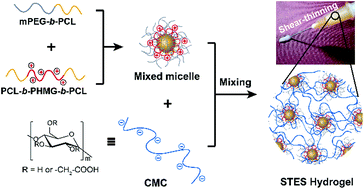A shear-thinning electrostatic hydrogel with antibacterial activity by nanoengineering of polyelectrolytes†
Abstract
Injectable shear-thinning hydrogels can be prepared by the non-covalent interactions between hydrophilic polymers. Although electrostatic force is a typical non-covalent interaction, direct mixing of two oppositely charged polyelectrolytes usually leads to a complex coacervate rather than an injectable hydrogel. Herein, a facile approach is proposed to prepare a shear-thinning hydrogel by nanoengineering of polyelectrolytes. Nanosized cationic micelles with electroneutral shells were prepared by mixing methoxyl poly(ethylene glycol)-block-poly(ε-caprolactone) and poly(ε-caprolactone)-block-poly(hexamethylene guanidine) hydrochloride-block-poly(ε-caprolactone) in an aqueous solution. When sodium carboxymethyl cellulose was added into the micellar solution, the outer poly(ethylene glycol) shell of mixed micelles prevented the instant electrostatic interaction between poly(hexamethylene guanidine) hydrochloride segments and sodium carboxymethyl cellulose, resulting in a homogenous shear-thinning electrostatic (STES) hydrogel. Because of the cationic poly(hexamethylene guanidine) hydrochloride segments, this hydrogel exhibits strong antibacterial activity against both Gram-positive and Gram-negative bacteria. Furthermore, the poly(ε-caprolactone) core of the mixed micelles can efficiently encapsulate a hydrophobic drug. In this work, curcumin-loaded STES hydrogel prepared by this method was used as wound dressing material that can promote wound healing even in infected wounds by further reducing bacterial infection via releasing curcumin. The present study provides a facile strategy to prepare shear-thinning antibacterial hydrogels from polyelectrolytes, which has great potential in biomedical application.



 Please wait while we load your content...
Please wait while we load your content...